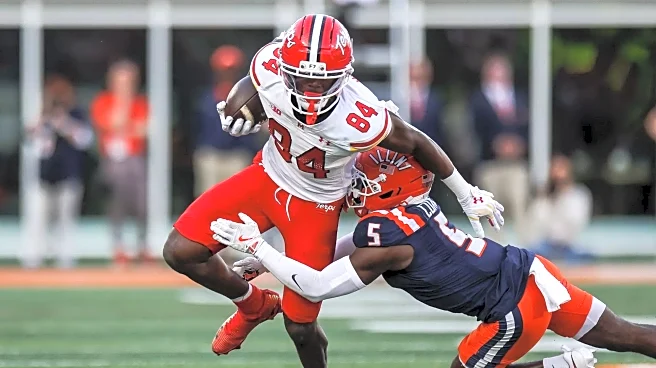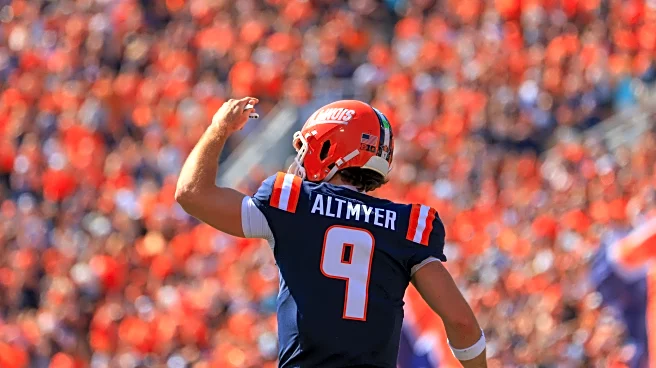Throughout the 2025 season, Maryland head coach Michael Locksley has referred to his team as a boat with holes, stating that he’s done the best he can to plug the holes with the players he has as more
and more pop up.
Now, that ship appears to be rudderless and on the verge of sinking. Maryland had a promising offensive drive early but settled for a field goal, with Illinois gradually building a lead that became insurmountable. Maryland lost, 24-6, while not reaching the end zone on three red zone trips.
Here are three takeaways from the game.
Defense again runs out of steam
Maryland’s defense, which already struggled with depth, was dealt significant blows pregame. The absence of Trey Reddick and DD Holmes left Maryland thin; a plethora of other injuries during the game made matters worse.
In the first half, though, Maryland’s defense looked solid, bouncing back from consecutive disappointing performances. Only No. 1 Ohio State and No. 2 Indiana held Illinois to fewer first-half points on the year than the 14 Maryland gave up.
Illinois quarterback Luke Altmyer found himself in uncomfortable spots numerous times, going 9-for-16 for 100 yards in the first half. The only easy pass he had early was the first touchdown, which came as Lavain Scruggs and Dontay Joyner appeared to fail at handing off the receiver. A late interception by Jalen Huskey was deserved for the Terps’ defense.
Eventually, though, Illinois simply had too much for Maryland to deal with. On the first defensive drive of the second half, Huskey got caught ballwatching for an easy touchdown — the second time secondary miscommunication doomed Maryland — and from there, the Terps couldn’t get a stop. Four of Illinois’ last five drives of the game, not including the game-ender, traveled 61 or more yards.
The biggest problem for Maryland, again, was defending the run. Illinois’ thunder-and-lightning attack earned them 225 yards on the ground, soaking up the clock and denying Maryland a chance to come back late.
Offense regresses to the mean
Maryland’s offense had a wildly uncharacteristic performance against Rutgers. The Terps rushed for 300 yards, more than double what it had managed in any other game this season, and quarterback Malik Washington passed for just 98 yards, less than half of what it had managed in any other game this season.
Against Illinois, the Terps reverted to a more expected formula on offense. Washington had 140 passing yards at halftime, and Maryland was once again ineffective running the ball. It finished with 3.1 yards per carry coming from 55 yards on 18 attempts, a stat line that looked much more familiar for Maryland football.
A new issue appeared as well: Illinois’ experienced defensive line consistently got hands in passing lanes, deflecting a notable number of passing attempts from Washington. The quarterback had to adjust and became more active in the pocket, which led to a few of the highlight throws Terps fans have become accustomed to seeing.
The Terps looked strong, but execution issues again plagued the Terps. One of those off-platform passes went the way of Dorian Fleming on fourth-and-goal in the fourth quarter. Maryland had marched all the way down from its own one-yard line, and they had an opportunity to make it a one-score game.
But Washington missed Shaleak Knotts wide open on a crossing route and forced a heroic pass to Fleming, who couldn’t make a grab on the loosely-spiraling ball. Indiana soaked up nearly six minutes on a drive going the other way before kicking a field goal to make it a three-score game.
Coaches gave up on their team
“We’re down to playing for pride, and opportunities for these guys to extend,” head coach Michael Locksley said after the Terps’ Nov. 8 loss against Rutgers.
With the team’s chances of making a bowl game doable with three games to go, albeit slim, it was surprising to hear the Terps’ leader imply that all Maryland had left was to play for pride.
After that field goal put Illinois up by 18, it became clear Maryland was not going to win the game Saturday. All the Terps had to play for at that point was that pride.
And so when Maryland had a chance to give its offense an opportunity to extend — facing a fourth-and-4 on their own 31-yard line with 3:43 to go — the decision to send out Bryce McFerson to boot the ball away was confusing.
The Terps had been offered a lifeline to even be in that situation: Illinois head coach Bret Bielema declined a holding penalty on Maryland’s backup offensive lineman Ryan Howerton on third-and-4. Suddenly, the Terps went from replaying a much longer third down to having an opportunity to get a first down and potentially sustain another drive.
Instead, Maryland punted.
With its defense incredibly injured and in atrocious form, there’s not a rational explanation of relying on them making a stop to fall back on that Locksley has turned to in other late-game punts.
However, that’s what he said.
“We’re two scores down, and if we pin ‘em in and we get a short field, we can score quick, kick an onside kick and then get it back, it’s a matter of trying to use the timeouts best,” Locksley said.
Maryland did spend one of its timeouts slightly drawing out the end of the game, but the other one went unused.
The offense had just proven they could move down the field — they pieced together a 95-yard drive minutes before. Several coaches prefer to wager on their offense — especially on a true passing down for Maryland. The only seemingly feasible explanation is the most obvious one.
Maryland’s coaches gave up on their players.
With the last home game of the season coming next, it will be fascinating to see how much Maryland’s fans have given up on their coaches.












